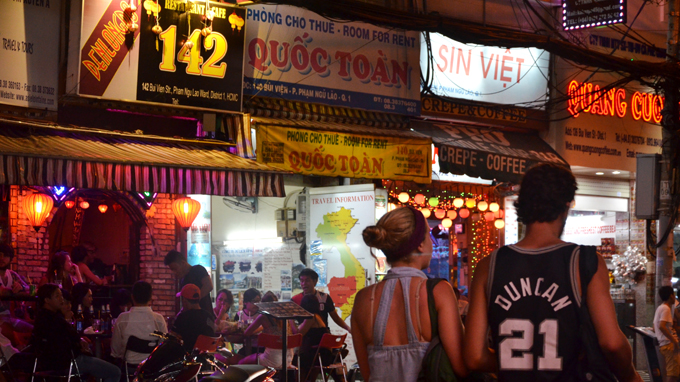In the memory of many Saigonese, there were only a few shops, restaurants and hotels in the Pham Ngu Lao area in the old days. Now it is well-known to global visitors as the Saigon backpackers’ area.
>> P1: Ho Chi Minh City backpackers’ town >> P2: The German who sells sausage on the sidewalk
Prior to 1975, residents living along Pham Ngu Lao Street often heard the sound of trains because the 23/9 Park contained of the former Sai Gon Central Railway Station. Today, that sound has been replaced by the bustling noise of a multicultural and multi-language area.
According to some sources, international travelers started gathering in the backpackers’ area in the late 1980s. More visitors began arriving in 1993 when it was mentioned in the Lonely Planet guidebook. It has exploded with business opportunities since then.
Huge profits
An elderly couple who wished to remain anonymous were among the first private guesthouse owners in the Pham Ngu Lao area. They revealed that they pocketed more than 10 taels of gold from their guesthouse per month during the glorious decade from 1993 to 2003.
In 1993, while working at the Saigon Port, the couple met a Japanese man by chance. He wanted to rent five rooms in their home, located downtown, for his employees for US$1,000 per month.
After careful consideration, the couple decided to take out a bank loan to build a house with six rooms – five for the foreigner’s staff and one for themselves. As the Japanese man was not patient enough to wait until the construction was completed, the couple accidentally ran their own guesthouse business from their home. But, after just two or three years of operating the business, they repaid the loan.
“Most of our customers at the time were French nationals who came to Vietnam to adopt local children. After that they took a bus to the Mekong Delta region or Nha Trang,” the wife said, adding that more hotels, bars, and restaurants, along with various services like laundry or air-ticket and tour booking services have sprung up since then.
The couple said that during the boom years a hotel room cost $30 per night in the high season and $20 in the low season, double the current price.
“We earned huge profits at that time. We used part of the profits earned from 1993 to 1997 to buy a nearby house to build a 16-room hotel,” the husband said.
But he admitted that profits have been lower since 2003, as more and more people - both locals and foreigners – have come to try their luck in business.
Unspoken competition
It is said that there is unspoken competition between “locals and foreigners” or “foreigners and foreigners” in the area. Therefore customers have more alternatives and enjoy quality services at more competitive pricing than ever before. Many people say the backpackers’ area is the cheapest place in the city to eat.
Visitors won’t have to walk far to find an ice cold beer in Pham Ngu Lao. For visitors who require nothing more than a place to sit and have a cold beer, cheap drinks offered at sidewalk shops on Bui Vien Street are not a bad choice.
Local people sell specialty bia hoi - a daily-brewed, fresh beer – at prices between 3,000 and 7,000 VND per glass. Bottles of Saigon Green or Red range from VND10,000 to VND12,000. Customers put their beer on plastic chairs on the pavement and enjoy the nightlife of Saigon.
Bia via he (a local term referring to cheap beer offered for sale on the sidewalk) is currently providing strong competition for high-priced bars and restaurants, where beer costs from VND25,000 to VND 35,000 per bottle.
A young Vietnamese woman who has been working in the area for more than a decade told Tuoi Tre that there is underground competition here. “The owner of the restaurant opposite us came to our restaurant and tried to lure our regular customers to his place despite the fact that we sell Italian food and he sells Indian food.”
She added that her boss was angry upon hearing this and tried to pull back his regular customers by talking to them as long as possible whenever they came to his restaurant.
Tiny Duyen Tran, the owner of Tiny Guesthouse in an alley on Pham Ngu Lao Street, draws costumers by providing her clients with free tourism information. “I provide them with any information they need so that they will not feel bad about Vietnam. I’m happy to do that”.
Mathew Ryan, 26, the owner of a bar on Bui Vien Street, said that the business is harder for foreigners but is not a challenge for him. “The community is quietly changing. There is more Vietnamese food. But I’m not afraid of the challenge because I have great support from my friends and regular customers.”
“My target customers in the future are Vietnamese who love western cuisine and music” – Ryan said.





















































